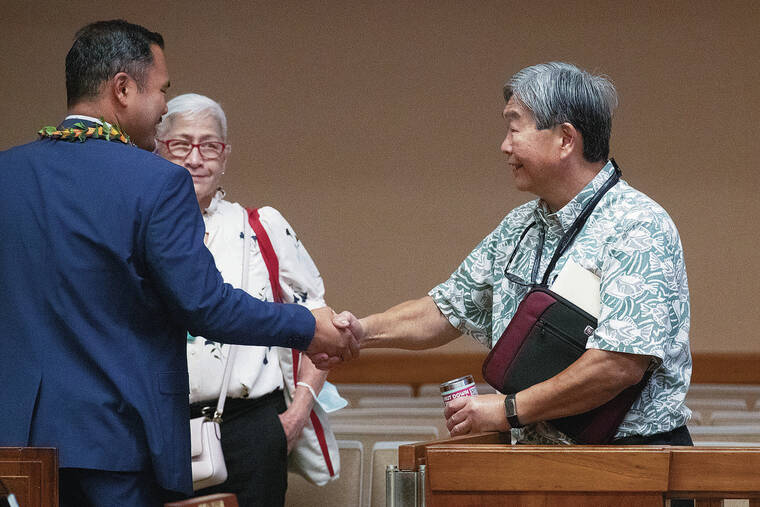Council OKs resolution for more water testing

GEORGE F. LEE / GLEE@STARADVERTISER.COM
Honolulu City Council member Tyler Dos Santos- Tam, left, shook hands with Ernie Lau, manager and chief engineer of the Board of Water Supply, following a hearing Wednesday at Honolulu Hale on Red Hill water testing.
The Honolulu City Council adopted a resolution Wednesday urging the Navy and Department of Defense to immediately implement weekly testing of monitoring wells related to past fuel spills at the Red Hill Bulk Fuel Storage Facility.
Introduced by Council Chair Tommy Waters and Vice Chair Esther Kia‘aina, Resolution 216 calls for the Navy and DOD to conduct weekly tests at all 36 of the Navy Red Hill monitoring wells and drinking water wells for all chemical contaminants stemming from past fuel and hazardous materials that were used, stored or released at the Red Hill facility.
The Council’s resolution was also amended to have water samples “submitted to a qualified, third-party laboratory facility for independent testing” of petroleum- related chemicals.
The resolution further requests installation of additional monitoring wells in the west and northwest direction beyond the Red Hill fuel facility.
The Honolulu Board of Water Supply detected polycyclic aromatic hydrocarbons at its closed Aiea Wells in water samples collected in May and June.
PAHs, a class of chemicals that occur naturally in coal and petroleum products like crude oil and gasoline, are known to cause cancer, respiratory issues and other health effects. The types of PAHs detected at the BWS Aiea Wells were also detected at the Navy’s monitoring well, NMW 24, in samples collected in June, indicating a contaminant plume might be migrating west of the Red Hill facility, the resolution states.
Don't miss out on what's happening!
Stay in touch with breaking news, as it happens, conveniently in your email inbox. It's FREE!
Before the vote, Waters noted that the once-top- secret World War II-era Red Hill facility was “built 100 feet above the Waimalu- Moanalua aquifer.”
“This aquifer supplies 77% of Oahu’s drinking water,” he said. “We know that there are 70-plus documented leaks, estimated at 644,000 to 1.94 million gallons that may have leaked from this facility. It has contaminated our drinking water.”
Ernie Lau, BWS manager and chief engineer, told the Council as far as the resolution goes, “We are in full support of the third-party, independent testing, done to the same rigor that the Board of Water Supply follows, and the same level of sensitivity, and it should be done weekly.”
“I also want to stress the importance of also requiring the military to test for PFAS — the forever chemicals — that we know were stored and used at Red Hill,” Lau said. “They should test at all monitoring well locations, even at new monitoring well locations, and those should also be done weekly.”
Lau added the city and state’s 2023 Red Hill Water Alliance Initiative report identified “at least over 100 different, additional monitoring” well locations that could be installed.
“And if you look at where the current monitoring wells are located, there’s like this broad swath of Halawa Valley — particularly on the (north side) — where there (are) very little monitoring wells being installed,” he said. “And that is the unknown. Because the concern was the westerly or northwesterly flow of the groundwater … that could transport contaminants to Aiea and Halawa communities.”
Council member Tyler Dos Santos-Tam asked whether additional monitoring wells would be built on lands either owned by the military or the city.
“It’s a variety of ownership, private ownership, some city, some state, but it’s a real mixed bag,” Lau replied. “So (the Navy) has concentrated their efforts on Navy property, or military property, and it’s easy because they are the landowner … but now it really comes down to drilling off their property.”
“Because that’s where the major gap of knowledge is, of what’s happening deep underground, it’s off of their property,” he said.
Lau also expressed his fear of having to shut down another drinking water source — namely, the Kaamilo Wells Pumping Station in Central Oahu — due to recent PFAS detection.
Lau noted that well, which pumps a million gallons a day to the Aiea community, is a half-mile west of the shuttered Aiea Well. He said an announcement on that well’s closure might come in “the near future.”
Many from the public also spoke on the need for water testing near Red Hill.
Among them, Sierra Club of Hawaii Director Wayne Tanaka said more scientific data was required “for not just us here now, but for our children, our grandchildren, and generations yet unborn.”
“Because the 200,000 to 2 million gallons of fuel that has been released from the Red Hill facility is going to be around for decades,” he said. “The PFAS, the forever chemicals, they’ll be around for centuries. So we need to do everything we can now to get the data and information that we will need … to prevent the worst impacts of this poison that’s now moving around in our groundwater, and to also prioritize remediation efforts going forward.”
Representatives of the Navy did not attend the meeting.
On Tuesday, the Navy, and its group responsible for shutting down the Red Hill fuel facility following massive 2021 fuel spills that sickened families, responded to Resolution 216.
“Navy Closure Task Force — Red Hill is aware of the Honolulu City Council’s proposed resolution and we look forward to working with our regulators and stakeholders on current and future actions regarding the long-term environmental assessment and remediation of the Red Hill Bulk Fuel Storage Facility and surrounding areas,” a Navy spokesperson previously told the Honolulu Star-Advertiser.
However, the Navy asserted the level of engagement between itself and BWS seemed lacking.
“Since Oct. 4, 2022, the Navy invited BWS on several occasions to collaborate and provide inputs to groundwater monitoring well locations and the draft Extended Drinking Water Monitoring Program that would mutually benefit our organizations and the community. The Navy has asked BWS to share which groundwater monitoring flow models they ascribe to, which would allow all of us to have continuous improvement on the scientific data,” the spokesperson said. “To date, BWS has not responded.”





